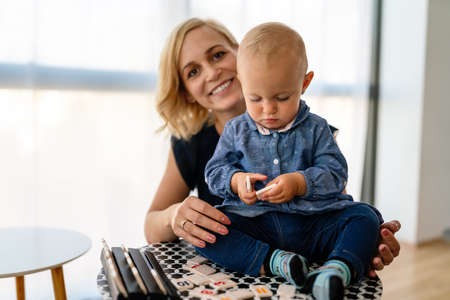1. Sensory Bins for Hands-On Exploration
Sensory bins are a fantastic way to engage your toddler in hands-on learning. These simple yet effective activities help develop fine motor skills, encourage creativity, and enhance cognitive development. By using different textures and materials, sensory bins provide endless opportunities for exploration.
How to Create a Sensory Bin
Setting up a sensory bin is easy and requires just a few materials. Choose a theme that interests your child and fill a container with engaging textures like rice, pasta, or water beads. Add small toys, scoops, or cups to encourage interaction.
Materials You Can Use
| Material | Description |
|---|---|
| Rice | A simple base material that’s easy to color and scoop. |
| Pasta | Dried pasta shapes offer different textures for little hands. |
| Water Beads | A squishy and fun way to explore texture and movement. |
| Kinetic Sand | Moldable and soft, great for building and sensory play. |
| Cotton Balls | A soft and fluffy option that toddlers love to touch. |
The Benefits of Sensory Bins
- Tactile Exploration: Helps children understand different textures through touch.
- Fine Motor Skills: Scooping, pouring, and grasping objects improve hand coordination.
- Cognitive Development: Encourages problem-solving and imaginative play.
- Sensory Regulation: Helps calm and focus toddlers by engaging their senses.
Themed Sensory Bin Ideas
You can make sensory bins even more exciting by adding themes based on your childs interests. Here are some fun ideas:
- Dinosaur Dig: Fill the bin with kinetic sand and hide small dinosaur figures for your child to discover.
- Ocean Adventure: Use blue-dyed rice, seashells, and plastic sea creatures for an underwater experience.
- Construction Zone: Fill the bin with dried beans or gravel and add toy trucks for a construction-themed play session.
- Sensory Garden: Use soil, fake flowers, and small gardening tools to create a mini garden experience.
Tips for a Mess-Free Experience
Sensory play can get messy, but with a few simple tricks, cleanup can be easier:
- Use a large tray or mat: Place the bin on a surface that’s easy to clean.
- Select easy-to-vacuum materials: Avoid tiny grains if you want quick cleanup.
- Create an outdoor setup: If weather permits, take sensory play outside for less indoor mess.
Sensory bins are an excellent tool to keep your toddler engaged while helping them learn through touch and exploration. Try different themes and materials to see what excites your little one the most!
Mess-Free Painting with Ziplock Bags
Let your toddler explore colors and textures without worrying about cleanup! This sensory activity is perfect for little hands to experiment with mixing colors while keeping everything tidy.
What You’ll Need
- Ziplock bag (gallon-size works best)
- Washable, non-toxic paint (two or more colors)
- Masking tape or painter’s tape
- A table or window
How to Set It Up
- Squeeze a few dollops of different colored paint into the ziplock bag.
- Seal the bag tightly, ensuring no air is trapped inside.
- Use masking tape to secure all edges of the bag onto a flat surface like a table or a window.
- Encourage your toddler to press, squish, and move the paint around inside the bag to mix colors and create unique patterns.
Why This Activity is Great for Toddlers
| Benefit | Description |
|---|---|
| Sensory Exploration | Toddlers can feel the texture of the paint through the bag while watching colors blend. |
| No Mess, No Stress | The sealed bag ensures that hands stay clean and surfaces remain spotless. |
| Fine Motor Skills Development | Pushing and spreading paint helps strengthen finger muscles needed for writing later on. |
| Cognitive Growth | Watching how colors mix teaches cause-and-effect relationships. |
| Creativity Boost | Your child gets to create their own “painting” in an engaging way! |
Tips for an Even More Fun Experience
- Add Glitter: Sprinkle a bit of fine glitter into the bag before sealing it for extra sparkle.
- Use Different Surfaces: Tape the bag to a window so sunlight shines through the colors.
- Name the Colors: Say each color aloud as your toddler mixes them together to support language development.
- Create Shapes: Help your child trace simple shapes with their fingers in the paint.
This mess-free painting activity allows toddlers to explore their creativity and learn about colors without any of the usual cleanup. It’s an easy, fun, and educational way to engage their senses!

3. Musical Play with Homemade Instruments
Music is a fantastic way to engage your toddler’s senses while helping them develop auditory skills, coordination, and creativity. You don’t need expensive instruments—everyday household items can turn into fun musical tools!
Easy DIY Instruments for Toddlers
Using simple objects from around the house, you can create engaging musical activities that help your child explore rhythm and sound.
| Household Item | How to Use |
|---|---|
| Pots and Pans | Let your toddler tap on them with a wooden spoon to create drum sounds. |
| Plastic Containers | Fill them with rice or beans to make homemade shakers. |
| Wooden Spoons | Banging two together creates a fun clapping sound. |
| Papertowel Rolls | Pretend they are horns or use them as microphones for singing. |
The Benefits of Musical Play
Toddlers love making noise, but musical play isn’t just about fun—it helps with sensory development in several ways:
- Auditory Skills: Listening to different sounds sharpens their ability to distinguish tones and rhythms.
- Cognitive Development: Music enhances memory, pattern recognition, and problem-solving skills.
- Fine Motor Skills: Holding small objects like shakers improves grip strength and hand coordination.
- Social Interaction: Playing music together strengthens bonding and communication skills.
Sensory Activity Idea: Musical Parade
Create a mini parade in your living room! Hand out homemade instruments and march around while playing music. This activity encourages movement, listening skills, and creativity—all while having fun!
Nature Walk and Texture Hunt
Exploring nature is a fantastic way to engage your toddler’s senses while encouraging curiosity about the world around them. A simple walk outside can turn into an exciting adventure full of different textures, colors, and shapes.
How to Set Up a Nature Walk
Take a stroll in a nearby park, garden, or even your backyard. Bring a small basket or bag so your toddler can collect natural items like leaves, rocks, flowers, or pinecones. Encourage them to touch and feel each object, describing its texture—smooth, rough, soft, or bumpy.
What Your Toddler Can Learn
| Sensory Element | Learning Benefit |
|---|---|
| Different textures (soft leaves, rough bark) | Enhances tactile awareness |
| Various colors in nature | Encourages color recognition |
| Shapes of leaves and rocks | Develops early observation skills |
| The scent of flowers or grass | Stimulates the sense of smell |
Fun Ways to Extend the Activity
- Create a Texture Collage: Once home, glue the collected items onto paper to make a sensory collage.
- Sorting Game: Have your toddler group objects by texture, color, or size.
- Nature Rubbing Art: Place leaves under paper and rub crayons over them to reveal patterns.
Helpful Tips for Parents
- Dress appropriately for the weather and choose safe areas for exploring.
- Avoid collecting anything that may be harmful, such as sharp objects or toxic plants.
- Encourage conversation by asking open-ended questions like, “How does this leaf feel?”
- If possible, bring a magnifying glass to examine small details up close!
5. Frozen Treasures Ice Play
Looking for a fun and refreshing way to engage your toddler in sensory play? Try Frozen Treasures Ice Play! This simple activity combines exploration, problem-solving, and fine motor skill development—all while keeping your little one entertained.
How to Set Up Frozen Treasures Ice Play
It’s easy to create this exciting sensory experience at home. Here’s what you need:
| Materials | Steps |
|---|---|
| Small toys or objects (plastic animals, buttons, beads, etc.) | Place small toys inside an ice cube tray or a larger container. |
| Water | Fill the tray or container with water, covering the objects completely. |
| Food coloring (optional) | Add a few drops of food coloring for extra visual appeal. |
| A freezer | Freeze the water overnight until solid. |
| Squeeze bottles, warm water, spoons, or toy hammers | Provide tools for your toddler to melt and break the ice. |
The Benefits of Frozen Treasures Ice Play
This activity is more than just fun—it offers several developmental benefits:
- Sensory Exploration: The cold temperature and smooth ice textures help toddlers develop sensory awareness.
- Fine Motor Skills: Using their fingers, spoons, or squeeze bottles strengthens hand muscles and coordination.
- Cognitive Development: As toddlers experiment with different ways to melt the ice, they practice problem-solving and critical thinking.
- Patiance and Focus: Waiting for the ice to melt teaches patience and keeps kids engaged in an extended activity.
Tips for Extra Fun
- Add different colors to each ice block for a rainbow effect.
- Create themed ice blocks with animal figures, letters, or numbers for educational play.
- If playing outdoors on a warm day, let your toddler explore melting ice in a sensory bin or kiddie pool.
Your little one will love the excitement of discovering hidden treasures while engaging in hands-on learning. Give it a try and watch their curiosity grow!


